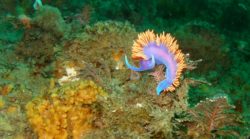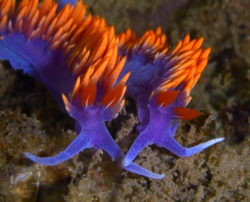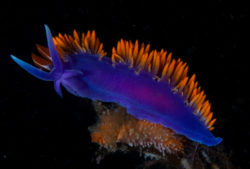
Sea Wonder: Spanish Shawl

A spanish shawl on the wreck of the Peacock in Channel Islands National Marine Sanctuary. Photo: Stuart Halewood
The Spanish shawl (Flabellinopsis iodinea) is a strikingly beautiful species of sea slug that is almost impossible to miss. Admire their beauty all you want but resist the temptation to touch! Their vibrant coloration isn’t just for show, it is a natural form of defense that allows these marine invertebrates to blend in with their environment and signal to potential predators that they may be poisonous.
Description
The most notable characteristic of Spanish shawls is their neon-colored bodies. They have purple-pink bodies, orange fringe, and two red rhinophores atop their heads. The rhinophores resemble rabbit ears or antennae and allow the animals to interpret smell and taste signals from their surrounding environments. The fringe on their backs are a set of organs called cerata, which function both as gills that remove oxygen from the surrounding environment and as extensions of the digestive system; the cerata contain stinging cells at the tips. When fully grown, Spanish shawls reach lengths of nearly three inches and a mere half-inch wide. Their jelly-like bodies are primarily made of water.
Diet & Habitat

A pair of spanish shawl nudibranchs eating Eudendrium Hydroids in Monterey Bay National Marine Sanctuary. Photo: Robin Agarwal
Spanish shawls are quite picky when it comes to their diets. They eat hydroids, a family of invertebrates that are related to sea anemones, jellyfish, and corals. The hydroids they primarily feed on are part of the family, Eudendriidae, which are known as tree hydroids, provide Spanish shawls with the biological building blocks that give them their brilliant hues – a toxin called astaxanthin. Spanish shawls can’t produce their own stinging cells, but instead store it after eating animals that can, a biological process known as chemical sequestration.
They also eat sea anemones, gorgonian corals, bryozoans, and the eggs of other mollusks. Since their prey are mostly sedentary, Spanish shawls don’t need highly sophisticated foraging methods to feed. A larger sea slug, the navanax, is one of the few known natural predators of Spanish shawls and has a biological immunity to the shawls’ stinging cells.
Spanish shawls are native to the West Coast and prefer shallower coastal waters, specifically the intertidal areas where food is plentiful. Their range spans from British Columbia down to Baja California in Mexico and to the Galapagos Islands off the coast of Ecuador. In the National Marine Sanctuary System, we see these slugs in all five West Coast sanctuaries.
Life History
The maximum lifespan of a Spanish shawl is short – from a few months to a year. Like many other sea slug species, these nudibranchs are hermaphroditic, possessing both male and female structures or tissues. Self-fertilization is rare but does occur. Usually, though, two slugs mate by both laying long, ribbon-like strings of egg sacs that are bright pink-orange. Both individuals then deposit sperm into the egg case they did not produce to promote genetic diversity. Spanish shawls may mate with multiple partners in a given season (usually the hemispheric autumn), and eggs hatch within a week of fertilization.
Spanish shawl larvae are small and helpless against the ocean’s currents, and most are eaten before they reach their juvenile life stage. Larvae and hatchlings feed on planktonic organisms before they reach adulthood. Spanish shawls are usually independent but live near other individuals, though we don’t know much about their social behaviors. These slugs reach adulthood within a few months of hatching and spend most of the remainder of their lives eating. They can use their muscular “foot” structure on their undersides to crawl along the ocean floor, leaving behind a sticky trail of mucus, or, unlike most other nudibranchs, they can swim. To do so, they contort their entire bodies back and forth into a U-like shape. Their name comes from this movement, which looks like a fringed fabric shawl floating in the ocean.
Threats & Conservation
The global population of Spanish shawls is not well studied, so we can’t be certain of their overall population health as it relates to their historical abundance. As a result, they are not listed on lists of threatened or endangered species. We know the threats this and other species of sea slugs face, however. They include pollution, habitat loss, climate change and ocean acidification, and decreased prey availability.

Spanish Shawl seen in Channel Islands National Marine Sanctuary. Photo: Cindy Shaw
